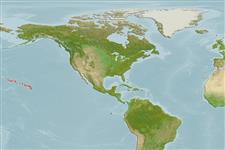>
Ovalentaria/misc (Various families in series Ovalentaria) >
Pomacentridae (Damselfishes) > Glyphisodontinae
Etymology: Abudefduf: Arabic, abu = father; this fish is the leader of the reef against other species (Ref. 45335).
More on authors: Quoy & Gaimard.
Environment: milieu / climate zone / depth range / distribution range
Ecologia
marinhas associadas(os) a recifes; não migratória; intervalo de profundidade 1 - 50 m (Ref. 9710). Tropical; 28°N - 15°S, 176°W - 154°W (Ref. 56014)
Eastern Central Pacific: Midway Islands (Ref. 7247) and Hawaii southward to central Polynesia.
Tamanho / Peso / Idade
Maturity: Lm ? range ? - ? cm
Max length : 30.0 cm TL macho/indeterminado; (Ref. 9710)
Descrição breve
Chaves de identificação | Morfologia | Morfometria
Espinhos dorsais (total) : 13; Raios dorsais moles (total) : 13 - 15; Espinhos anais: 2; Raios anais moles: 13 - 15. Similar to A. bengalensis but has fewer vertical stripes, a black blotch on the posterior base of the dorsal and anal fins, and pointed caudal fin lobes.
Found in quiet waters with rocky bottoms in inshore and offshore reefs; juveniles sometimes found in surge pools (Ref. 205). Benthopelagic (Ref. 58302). Adults form school. Feed on a variety of algae and zooplankton. Oviparous, distinct pairing during breeding (Ref. 205). Eggs are demersal and adhere to the substrate (Ref. 205). Males guard and aerate the eggs (Ref. 205). Used as food by the Hawaiians (Ref. 7364).
Life cycle and mating behavior
Maturidade | Reprodução | Desova | Ovos | Fecundidade | Larvas
Distinct pairing (Ref. 205). Male guards and aerates eggs (Ref. 205).
Allen, G.R., 1991. Damselfishes of the world. Mergus Publishers, Melle, Germany. 271 p. (Ref. 7247)
Categoria na Lista Vermelha da IUCN (Ref. 130435: Version 2024-1)
Ameaça para o homem
Harmless
Utilização humana
Pescarias: pouco comercial; Aquário: Espécies comerciais
Ferramentas
Relatórios especiais
Descarregue XML
Fontes da internet
Estimates based on models
Preferred temperature (Ref.
123201): 24.2 - 25.5, mean 25.1 °C (based on 54 cells).
Phylogenetic diversity index (Ref.
82804): PD
50 = 0.5000 [Uniqueness, from 0.5 = low to 2.0 = high].
Bayesian length-weight: a=0.02630 (0.01392 - 0.04970), b=3.11 (2.95 - 3.27), in cm total length, based on LWR estimates for this species & Genus-body shape (Ref.
93245).
Nível Trófico (Ref.
69278): 3.0 ±0.33 se; based on food items.
Resiliência (Ref.
120179): Médio, tempo mínimo de duplicação da população 1,4 - 4,4 anos (Preliminary K or Fecundity.).
Fishing Vulnerability (Ref.
59153): Low vulnerability (20 of 100).
Nutrients (Ref.
124155): Calcium = 51.9 [27.3, 83.3] mg/100g; Iron = 0.561 [0.351, 0.878] mg/100g; Protein = 18.4 [17.3, 19.5] %; Omega3 = 0.104 [0.068, 0.158] g/100g; Selenium = 31.9 [18.8, 56.0] μg/100g; VitaminA = 63.3 [18.2, 207.4] μg/100g; Zinc = 1.24 [0.88, 1.74] mg/100g (wet weight);
